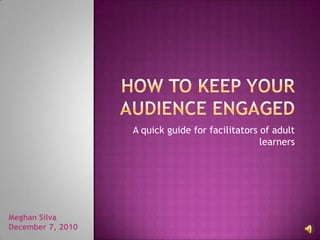
How to keep your audience engaged
- 1. How to Keep your Audience Engaged A quick guide for facilitators of adult learners Meghan Silva December 7, 2010
- 2. Enviornment First make sure learners feel like they are part of the learning experience and that they can contribute to the discussion. This can be accomplished by making sure the seats in the room are in a format which will allow for easier communication between learners. Examples include a circle, semi-circle or square where all participants are facing each other.
- 3. Personal story If applicable, start with a personal story or experience. This will make you more relatable to the audience and they will be more likely to listen to your thoughts and opinions in the future. You want to develop a relationship with the learners right away, this will help them see the environment as a safe place to share ideas and opinions.
- 4. Beginning to end When it comes time to learn new information, it helps to know what the facilitator has planned for the meeting. This relieves stress and issues regarding time management. Audience members will appreciate this, and will be able to schedule their absences strategically if necessary.
- 5. Tone of voice Do your best to avoid speaking in a monotone voice. You need to make sure your audience is engaged at all times. You can avoid this by facilitating more class discussion, which will lessen the time you are in front of the class lecturing. If you must lecture, consider using a co-instructor that will give the audience a different perspective.
- 6. Have a visual aid Many learners can benefit from having a visual aid when being introduced to new concepts. Examples include, printed out class notes, a PowerPoint with key points, or video clips. Having a visual aid will also help you, the facilitator, keep track of how and when to present material.
- 7. Let me see a Show of hands At different points throughout the presentation, ask the audience questions which require a show of hands. If the audience members know they are responsible for contributing with a show of hands, they are more likely to remain engaged in the lecture.
- 8. Group work Another way to engage your audience is to let them stop and work in pairs or a group to complete tasks. This will help by allowing the audience members to focus on another task besides listening to a lecture. This will allow them to learn from each others ideas as well as the facilitator.
- 9. Role plays In addition to group work, another way to engage your audience is to incorporate role plays into your presentation. What better way to show what you are trying to explain than to use the willing members of the audience to demonstrate key concepts!
- 10. Case studies In addition to using audience members to demonstrate key concepts, also consider using case studies that can show what you are trying to get the audience to learn. Case studies also allow the audience members to relate to the presentation more, especially if it is a circumstance they have encountered in their professional lives as well.
- 11. Assesment Give an assessment to your audience regarding what they have learned. The goal of this is to see if they were able to retain the key concepts of the lecture. Although this specific tool may not help in engaging your audience, it can help in future planning if certain concepts were not learned by the majority of participants. It will help you decide what material to keep and what material you might not need to present in the future.
- 12. Break time! Be sure to give audience members a small break to collect their thoughts or to leave the room for a brief amount of time. Try to limit audience members being pre-occupied. Depending on the length of the presentation, learners may need to use building facilities or the water fountain. Plan time for this and you can guarantee a more engaged audience!
- 13. COnclusion Remember to: Create a pleasant environment Start with a personal story Give a small break Use tools such as role plays and case studies Have the learners work in groups Let the learners know the plan for the meeting Use a visual such as PowerPoint or a video clip Avoid using a monotone voice!